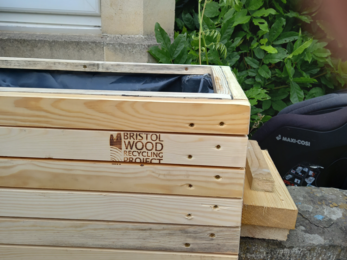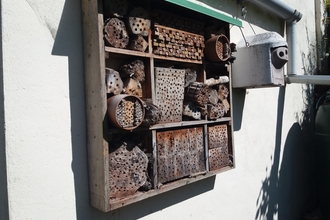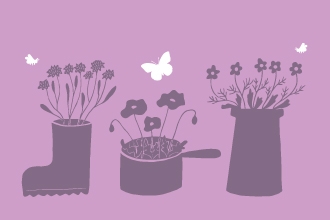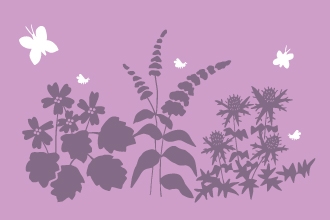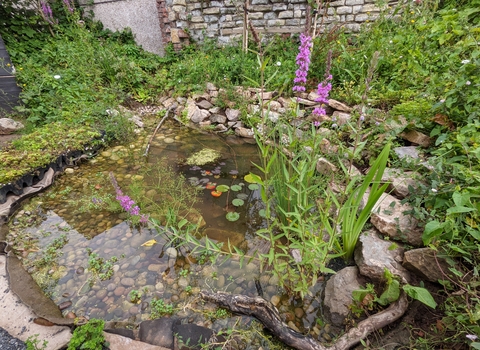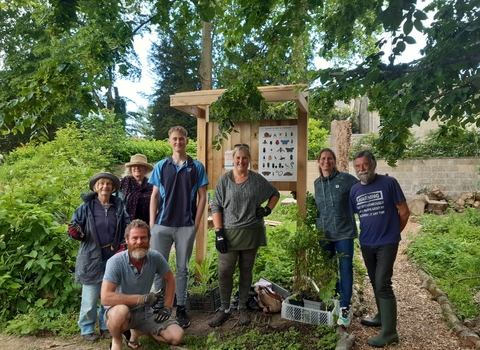
Kelly Bray
Wild Roads
Creating wildlife corridors in your street
In early August 2024 residents of Camerton Road came out in force to install and plant-up 12 planters. Local resident Estelle highlights how you can create wildlife corridors in your street.
Estelle was inspired by the actions taken on Stanley Park Road in Easton. A project coordinated by Avon Wildlife Trust back in 2015 called My Wild Street that transformed the road where wildflower planters where installed, green roofs were added to wheelie bins, and pergolas for creeping plants squeezed in. The gardens were filled with bug hotels, log piles and bird baths to encourage critters of all shapes and sizes to make the gardens their homes.
Estelle and other local residents began to really understand the severity of the decline in insects and the impacts of this decline in the UK and across the world through the work and books of Professor Dave Goulson from the University of Sussex. Reading some of the stats was pretty depressing, but they also felt hopeful that their community could do something to help.
Although insects are under serious threat, they remain one of the most diverse and abundant creatures in the world and have short life cycles. Residents of Camerton Road wanted to give insects an opportunity to recover, the chance to rebound strongly, even if just locally.
It can be really hard to remain hopeful in face of the huge threats our planet faces, but this was something they knew they could all get involved with and behind… and hopefully see tangible change! They just had to figure out a way to sustainably increase habitat and food resources on their street for pollinators.
Creating a wild road
Communication
We have an active whats app group – I messaged everyone about the idea about a year ago.
What was the response from the street?
Everyone on the street was really excited to get involved and of around 37 houses, 34 households were keen for planters outside of their homes, if we could achieve the funding for it.
Funding
Applied for funding but was not successful but got in touch with Avon Wildlife Trust who were running their Nextdoor Nature Project that supports communities to help make their ideas a reality. They were also able to help fund the planters through their support fund.
Free advice
We got advice from Grow Wilder on what plant species to chose on the basis of their flowering window, so food is available for a wide range of pollinators from spring to early autumn, with a focus on native perennial species. The planters were pre-made by Shedzone at the Wood recycling project.
Street closure
We organised a street closure for the day, the planters were delivered along with the wildflowers and soil from grow wilder. Neighbours with drills started to fix the planters to the wall while others filled them with soil ready to plant up. To keep everyone going I was able to get cakes donated from Cakesmiths, with celebratory beers from Lost and Grounded and the Beer Factory and one of my neighbours made baps for everyone.
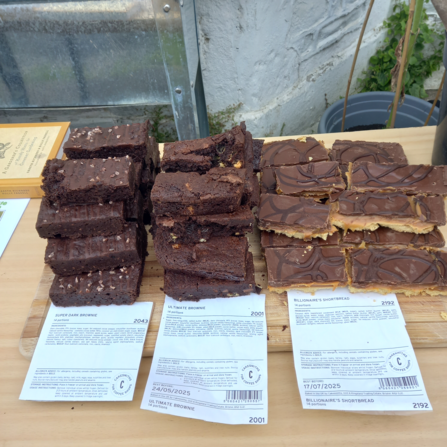
Kelly Bray
Expected changes for wildlife and the community
Not everyone on the street has a back garden. Those that are lucky to have a garden may not have the time, knowledge or resources to garden for wildlife. Estelle wanted this project to be accessible to everyone. Allowing street volunteers to water and maintain the planters will contribute to a sense of community. Easton is one of the most disadvantaged areas in Bristol so having the planters visible here could improve access to nature and mental wellbeing among residents.
Installing the planters as a community has given a sense of pride and ownership over a conservation solution, encouraging further engagement by residents in conservation such as making bigger pollinator positive changes to their own garden.
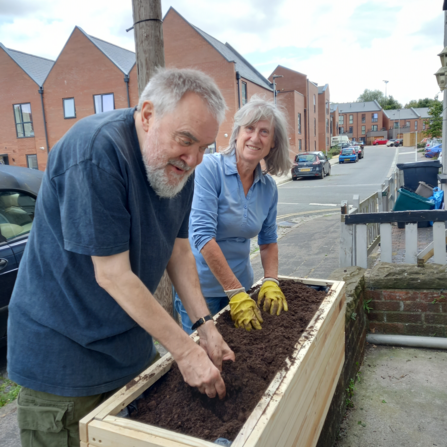
Kelly Bray
A big hope is that the street can measure insect abundances on the streets after the implementation of the planters to ascertain their scientific significance. We could do this via an app like the Pollinator FIT app.
Hopefully over the years we can increase the number of houses on the street and in the Easton area generally, that have planters outside of their house. Visibility to the wider public will increase awareness of the importance of insects. Planters will have small signs so people can find out more.
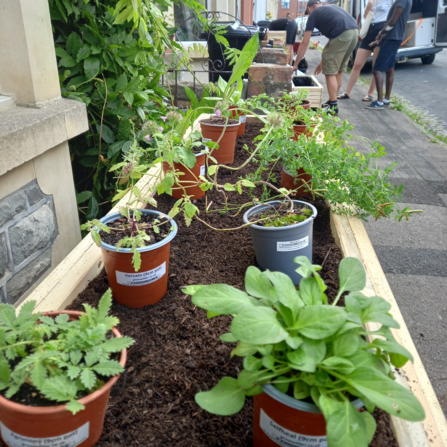
Kelly Bray
This is the most beautiful gift Estelle could have done for the street.
My nextdoor neighbour is away and they have just had a baby, and what I have loved doing- I have joyously done their planter, it feels beautiful to be doing something for your neighbours. It’s also been great to meet up with neighbours that I haven’t seen for a while.
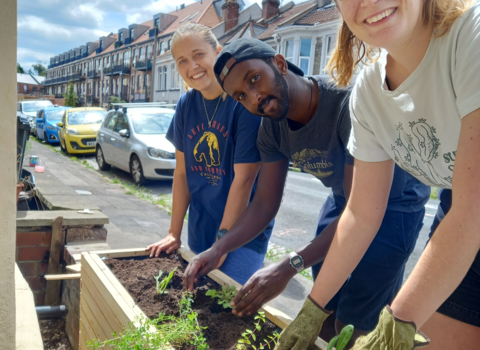
Kelly Bray
Creating a Wild Road
- Start small and think local.
- Get local residents together for mutual agreement for action to be taken. Eg. Street planters, litter pick, get togethers etc. Make it relevant and accessible for everyone. Everyone has a skill to share, incluidng making tea!
- Think long term to make project last. Who will water the plants? Can anyone measure impact, such as through wildlife surveying?
- Decide how to communicate - WhatsApp group, messenger, email or print? Signage to show what you're doing can help.
- Organise the group to get funding.
- Get free advice - Team Wilder at AWT, Grow Wilder wildflower nursery, other local community groups.
- Event - make the event fun for the community, ask for freebies from local businesses.
Advice about creating a Wild Street
Sharing lessons learned from the process and challenges faced:
Vision
When coming up with an idea to help nature, I think it’s a good idea to think big initially. For me, this meant imagining a Bristol where every road and corner possible was covered in flowers and plants for pollinators. Obviously, that wouldn’t happen overnight, but it led me to think about how we could achieve this locally.
Funding
On a practical note, I wanted this project to be as inclusive as possible, so I wanted to get funding for it, rather than asking residents to pay for it. Applying for public funds when you don’t have any experience in doing so can be a bit bewildering and I found it was a real learning curve. It involves finding all the people you need to make an idea work and come to life, writing up timelines and budgeting. But there are many resources out there and so many people who are willing to help with this sort of thing so don’t be afraid to reach out. In our case, it was great getting advice on the funding applications from people and organisations like the Eastside Community Trust, Hazelnut Community Farm, Barry Parsons (one of Easton's councillors) and the Avon Wildlife Trust.
Avon Wildlife Trust also has a very useful website and resources geared towards helping individuals and local communities with funding applications and understanding how they can make a difference locally:
Team Wilder Find a Funder
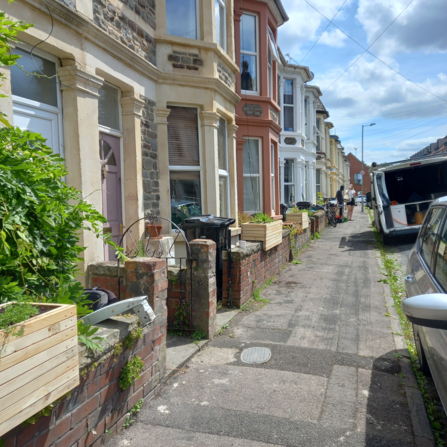
Kelly Bray
Registering the group
As an ad hoc, new and small community project, we were not registered officially as group or a charity with a group bank account, which are often requirements for funding applications. To overcome this, Eastside Community Trust was happy and able to be the lead organisation for the project, which widened the number of applications we were eligible for. In the end, we received funding from Avon Wildlife Trust’s Nextdoor Nature Fund which did not require an individual or community to be officially registered as a group or charity. This is a great funding model, in my opinion, as it makes it easier and simpler for local people to come up with and initiate ideas.
Team Wilder group classifications explained
Trees on the street?
At the beginning when thinking about ways to increase habitat on our street for pollinators we discussed the possibility of planting trees on the street and constructing big planters on the road in place of a few car parking spaces. Though the latter could have been cheaper and perhaps allow for a larger square metreage of habitat to be created, they were not as practical as solutions for a number of reasons. Firstly, the streets in our area are narrow, so tree planting could hinder access for people in wheelchairs or people with prams. Secondly, placing planters on public roads would have needed sign off and consent from the council, which could have delayed the project and we knew that the pollinators needed help ASAP.
Community involvement is key
Getting your community involved and pitching in with ideas early on is super really helpful, not to mention, very motivating!
Lastly, don’t give up.
Although we weren’t successful in getting the funding in 2023, it was helpful to understand why we didn’t get it and make improvements to our applications thereafter. There are lots of ways you can get funding so just keep looking and asking people for advice.

Heritage fund, the Queen's Jubilee and The Wildlife Trusts
Resources

(C) Hannah Bunn
Be part of Team Wilder
All actions for nature collectively add up and creates life for people and wildlife.
Share your actions for nature, like Tom by sharing and tagging @avonwt on social media and
Log your actions for nature on the map


